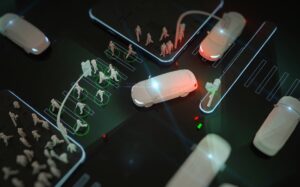A new study looking at Vehicle-to-Everything (V2X) connectivity and autonomous driving technologies shows the combination is the best-case scenario for traffic flow

A new study from the North Carolina State University has found that increased adoption of connected and connected autonomous vehicles decreases congestion at intersections, positively impacting traffic flow. Image: Autocrypt
A new study looking at Vehicle-to-Everything (V2X) connectivity and autonomous driving technologies shows the combination is the best-case scenario for traffic flow

This article is partner content presented by Autocrypt.
It’s 5 pm and you’ve just left work.
But that isn’t the end of the day. Maybe you have to pick up your children, take care of a family member, or run some errands before heading home.
Regardless of your evening plans you are now sitting in bumper-to-bumper traffic with a wall of red taillights in front of you, looking at an hour and a half commute to make it the 20km home.
This is the reality of driving in any urban area today. Just a decade ago, when urban living was less dense and cars less prolific, “rush hour” really was just an hour. Now there are only two times of day for driving: gridlock (the hours between 5:30am to 11:30pm) or the middle of the night.
But it doesn’t have to be this way.
A new study from the North Carolina State University has found that increased adoption of connected and connected autonomous vehicles decreases congestion at intersections, positively impacting traffic flow.
“The results show that CAVs [connected autonomous vehicles] provide the most efficient mobility,” reads the study, entitled The Effects of Connectivity and Automation on Saturation Headway and Capacity at Signalized Intersections.
“CVs [connected vehicles] also improve mobility due to receiving information about the future signal timing plans.”
CAV vs CV vs AV
The North Carolina State study looked at three vehicle types: connected autonomous vehicles (CAVs), connected vehicles (CVs) and autonomous vehicles (AVs).
They compared the performance of each of these types to a “base” standard of driving through intersections with only human drivers at the wheel.
The findings concluded that CAVs and CVs out-perform both human drivers and AVs.
“[T]he highest increase (80%) and decrease (20%) in lane group capacity are observed respectively in a traffic stream of 100% CAVs and 100% AVs,” states the report.
Why is this?
It comes down to technology. The study shows that it’s not enough for a vehicle to be able to drive itself. That may work in isolation (if it’s the only vehicle on an otherwise empty road, which is a rather unlikely scenario), but when the world is happening around the vehicle, the autonomous technology needs to be able to interact with the infrastructure.
That is what connected and connected autonomous vehicles do.
For example, a CAV can “see” the road, by exchanging messages with infrastructure around the vehicle in real time. This infrastructure includes traffic lights, traffic volume and the behaviour of other vehicles. All this information helps the CAV to tailor its own operations to the activities happening around it so that it’s working with traffic, not against it.
“While ADAS inches us closer to autonomous driving, full autonomy is only possible with connectivity technologies like V2X. Connectivity allows us to see beyond the blind spots of sensors and radars, easily understanding circumstances around us from the shared data, creating a safe environment for a truly autonomous driving experience,” says Autocrypt’s CEO and co-founder, Daniel ES Kim.
Benefit ripple effect
The perk of saving time on traffic will, for many commuters, be enough to convince them that CAV and CV technology is a superior way of driving.
However, saving time is not the only benefit of vehicle connectivity.
Saving time in traffic also means better fuel and energy usage for combustion and zero-emission vehicles, respectively.
Real-time communication with other cars on the road and the infrastructure also allows for coordinated movement on the roads. This leads to a significant reduction in the number of accidents and, in those cases where an accident does happen, the roads can be cleared more quickly for emergency vehicles to attend.
“Technology like V2X works best at scale. To reap the maximum benefits of safety, improved traffic flow and full autonomy; connectivity technologies must be supported by governments on the infrastructure side and OEMs on the vehicle side,” says Kim.
As a point of interest, the OPP recently released data that shows road accidents in Ontario saw a 20 per cent spike in collisions compared to the previous year.
CAV and CV technology could make many of these preventable.
A new transportation future
The idea that cars can “speak” to pedestrians or to other vehicles or to traffic lights can seem entirely futuristic.
But the technology is way beyond the point of being just an idea.
Today, connected technologies are being deployed all around the world. According to an analysis from Deloitte, “there will be 470 million connected vehicles on highways around the world by 2025.”
Canada has been slow to move into vehicle-to-everything (V2X) technology, but a 2017 government report underscores the importance of embracing the technology.
“The three separate technologies of shared mobility, automation and electrification are mutually reinforcing,” reads the Information and Communication Technology Council report.
“The successful convergence of these three innovations is vital to the future of AVs and deploying AVs thoughtfully is vital to the future of cities.”
It’s encouraging that Canadian policy makers are aware of the importance of moving to V2X technology.
“Bridging the gap between the status quo and the full potential of connectivity technologies will take a lot of effort from the entire industry. Therefore, governments and OEMs must collaborate, invest and implement regulations to swiftly deploy V2X technologies and reap the benefits of connectivity, says Kim.
Autocrypt is proud to offer its secure V2X solutions and expertise to Canadian governments and businesses looking to make this needed and beneficial transition.






